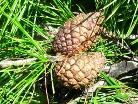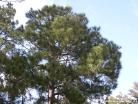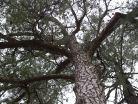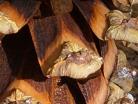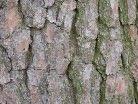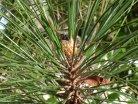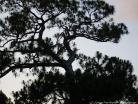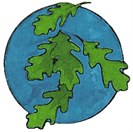
Sources:
Trees of North America- A guide to field identification-a Golden Field Guide from St. Martin's Press © 2002 By C. Frank Brockman p.28
FM- 21-76 US Army Survival Manual- 14th printing. Headquarters, Dept. Of the Army. 1999 Dorset Press, New York. New material ©1991 by Platinum Press, p. C-54
Diseases of Trees and Shrubs, 2nd edition, by Wayne A. Sinclair and Howard H. Lyon, © 2005 Cornell University, Cornell University Press, p. 296
The Encyclopedia of North American Trees by Sam Benvie. Firefly Books Ltd.,2000 Buffalo, NY © 2000 Sam Benvie p.186
Checklist of the Forest Trees of the United States, Their Names and Ranges- Bulletin No.17, US Department. Of Agriculture, Division of Forestry, by George B. Sudworth. Issued Nov. 5, 1898. p. 18
USDA, NRCS. 2011. The PLANTS Database (<http://plants.usda.gov/>, 22 August 2011). National Plant Data Team, Greensboro, NC 27401-4901
Sullivan, Janet. 1993. Pinus glabra. In: Fire Effects Information System, [Online]. U.S. Department of Agriculture, Forest Service, Rocky Mountain Research Station, Fire Sciences Laboratory (Producer). Available: http://www.fs.fed.us/database/feis/ [2011, August 22].
Trees of North America- A guide to field identification-a Golden Field Guide from St. Martin's Press © 2002 By C. Frank Brockman p.28
FM- 21-76 US Army Survival Manual- 14th printing. Headquarters, Dept. Of the Army. 1999 Dorset Press, New York. New material ©1991 by Platinum Press, p. C-54
Diseases of Trees and Shrubs, 2nd edition, by Wayne A. Sinclair and Howard H. Lyon, © 2005 Cornell University, Cornell University Press, p. 296
The Encyclopedia of North American Trees by Sam Benvie. Firefly Books Ltd.,2000 Buffalo, NY © 2000 Sam Benvie p.186
Checklist of the Forest Trees of the United States, Their Names and Ranges- Bulletin No.17, US Department. Of Agriculture, Division of Forestry, by George B. Sudworth. Issued Nov. 5, 1898. p. 18
USDA, NRCS. 2011. The PLANTS Database (<http://plants.usda.gov/>, 22 August 2011). National Plant Data Team, Greensboro, NC 27401-4901
Sullivan, Janet. 1993. Pinus glabra. In: Fire Effects Information System, [Online]. U.S. Department of Agriculture, Forest Service, Rocky Mountain Research Station, Fire Sciences Laboratory (Producer). Available: http://www.fs.fed.us/database/feis/ [2011, August 22].
Map courtesy USDA NRCS PLANTS Database
Virginia Pine,
Pinus virginiana Mill.
Pinus virginiana Mill.
State List: AL, DE, GA, IL, IN, KY, MD, MO, MS, NC, NJ, NY, OH, PA, SC, VA, WV ENDANGERED IN NY
Introduced in: Oklahoma, Albertia, British Columbia and Ontario
Visit the Image Gallery for more photos
Common names: Jersey Pine, Oldfield Pine, Possum Pine, Poverty Pine, Scrub Pine, Shortstraw Pine, Spruce Pine, Virginia Pine
A native conifer, the Virginia Pine is a short to moderately lived tree, rarely reaching 150 years in age, and usually begins to decline between 65 and 90 years old. Sometimes ragged or shrubby on poorer sites, Virginia pines only grow to a height of 25 feet in 20 years and reach a mature height between 40 and 70 feet. Most trees do not exceed 1.5 feet in diameter. Pinus virginiana has a flat, open, irregular crown with long, heavy branches often extending to the ground on short stemmed (trunk) trees. Generally, the root
Introduced in: Oklahoma, Albertia, British Columbia and Ontario
Visit the Image Gallery for more photos
Common names: Jersey Pine, Oldfield Pine, Possum Pine, Poverty Pine, Scrub Pine, Shortstraw Pine, Spruce Pine, Virginia Pine
A native conifer, the Virginia Pine is a short to moderately lived tree, rarely reaching 150 years in age, and usually begins to decline between 65 and 90 years old. Sometimes ragged or shrubby on poorer sites, Virginia pines only grow to a height of 25 feet in 20 years and reach a mature height between 40 and 70 feet. Most trees do not exceed 1.5 feet in diameter. Pinus virginiana has a flat, open, irregular crown with long, heavy branches often extending to the ground on short stemmed (trunk) trees. Generally, the root

system is shallow but is capable of growing a taproot over 60 feet down in deep sandy soils. The reddish brown to grayish bark is thin and can be smooth or flaky when young, eventually developing shallow fissures with somewhat shaggy irregular plates when mature. Stiff, twisted, grey green needles are 1 to 3 inches long and are borne in bundles of 2. They are also sharp tipped and both the needles and their sheaths can persist on the branches for up to 4 years. Within the needles are nearly stalkless female cones, which are 1.5 to 2.5 inches long, globose to narrowly oval, reddish brown with prickle tipped scales. They are most often found in pairs but may occasionally grow in clusters of 4. Cones mature in late September to early November in the second year and disperse small brown, single winged seeds October through January.
Habitat
Pinus virginiana is usually found growing in well draining poor soils of any texture with a pH range of 4.5 to 7.5. It is particularly well adapted to soils of marine origin and achieves best growth on clay or sandy loams. Native to lower elevations (50 to 2,500 feet), Virginia pine is shade intolerant and prefers mixed hardwood-pine communities with hilly terrain. Highly drought tolerant, annual rainfall needs are 32 to 65 inches. Virginia pine is cold hardy down to -23°F, requires cold stratification, and 165 frost free days.
Habitat
Pinus virginiana is usually found growing in well draining poor soils of any texture with a pH range of 4.5 to 7.5. It is particularly well adapted to soils of marine origin and achieves best growth on clay or sandy loams. Native to lower elevations (50 to 2,500 feet), Virginia pine is shade intolerant and prefers mixed hardwood-pine communities with hilly terrain. Highly drought tolerant, annual rainfall needs are 32 to 65 inches. Virginia pine is cold hardy down to -23°F, requires cold stratification, and 165 frost free days.
Photo citation: Steve Hurst @ USDA NRCS PLANTS Database
Pests, Diseases and Elemental
While resistant to ozone damage, Pinus virginiana has a low fire tolerance and only the largest individuals typically survive. The main disease concern for Virginia pine is Pine oak gall rust, Chronartium quercum f.sp. virginianae, which causes blister covered globose galls to develop. In addition to Pine oak gall rust, other diseases associated with this native pine tree are heart rot and pitch canker. There are many insect pests, including southern pine beetles, redheaded sawflies, Virginia Pine sawflies, and pales weevils. Young trees may also be girdled by rodents such as field mice.
Uses
Pinus virginiana is not a commercially valuable tree species. In addition, its
While resistant to ozone damage, Pinus virginiana has a low fire tolerance and only the largest individuals typically survive. The main disease concern for Virginia pine is Pine oak gall rust, Chronartium quercum f.sp. virginianae, which causes blister covered globose galls to develop. In addition to Pine oak gall rust, other diseases associated with this native pine tree are heart rot and pitch canker. There are many insect pests, including southern pine beetles, redheaded sawflies, Virginia Pine sawflies, and pales weevils. Young trees may also be girdled by rodents such as field mice.
Uses
Pinus virginiana is not a commercially valuable tree species. In addition, its
value actually decreases with stand age. It is, however, gaining in popularity for use in pulpwood products but its chief use is in reforestation of mines and old agriculture fields (hence the name oldfield pine). Virginia pine is also an aggressive invader of burned sites. Like all pine trees, resin can be collected and used in the production of turpentine. Turpentine has been used in times past in treatments of a variety of ailments. Respiratory complaints like coughing, bronchitis, common colds, and influenza were eased by steam baths and inhalers. Skin problems, wounds and sores were also treated with poultices and salves. In the late 1800's, it was even used to treat tuberculosis. The seeds of all pines are edible and in emergency situations, several parts of the tree can be used as food. The inner bark is full of vitamins and sugars and can be chewed, while in the spring, young male cones can be boiled or baked then eaten. Also, young twigs are edible once the outer bark is peeled away. Besides turpentine, the resin, or sap, can be heated then spread on items needing to be waterproofed and may also be mixed with ash and used as a glue while hot.
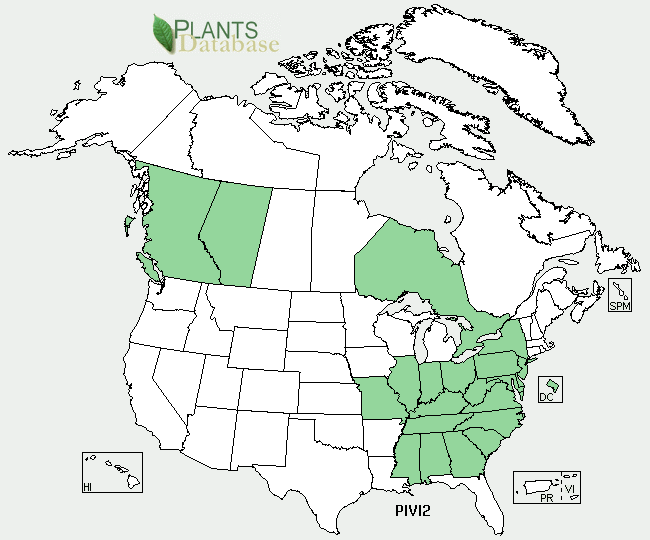
Possible synonym: Pinus inops Solander ex Ait
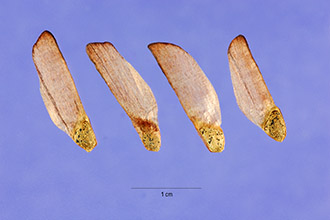




™
- Trees
- A-Z scientific
- A-Z by Common Name
- Families
- Aceraceae Maple Family
- Anacardiaceae Sumac Family
- Annonaceae Custard Apple Family
- Aquifoliaceae Holly Family
- Arecaceae, Palm Family
- Betulaceae Birch family
- Bignoniaceae Trumpet Creeper Family
- Burseraceae Frankincense Family
- Caprifoliaceae Honeysuckle Family
- Chrysobalanaceae Coco-plum Family
- Cornaceae Dogwood Family
- Cupressaceae Cypress Family
- Cyrillaceae Cyrilla Family
- Ebenaceae Ebony Family
- Ericaceae Heath Family
- Fabaceae Pea Family
- Fagaceae Beech Family
- Hamamelidaceae Witch Hazel Ffamily
- Hippocastanaceae Horse Chestnut Family
- Juglandaceae Walnut Family
- Lauraceae Laurel Family
- Leitneriaceae Corkwood Family
- Magnoliaceae Magnolia Family
- Meliaceae Mahogany Family
- Moraceae Mulberry Family
- Myricaceae Bayberry Family
- Myrsinaceae Myrsine Family
- Myrtaceae Myrtle Family
- Nyctaginaceae Four Oclock Family
- Olacaceae Olax Family
- Oleaceae Olive Family
- Pinaceae Pine Family
- Platanaceae Plane Tree Family
- Polygonaceae Buckwheat Family
- Rhamnaceae Buckthorn Family
- Rosaceae Rose Family
- Rubiaceae Madder Family
- Rutaceae Rue Family
- Salicaceae Willow Family
- Sapindaceae Soapberry Family
- Sapotaceae Sapodilla Family
- Simaroubaceae Quassia Family
- Styracaceae Storax Family
- Symplocaceae Sweetleaf Family
- Theaceae Tea Family
- Tiliaceae Lindon Family
- Ulmaceae Elm Family
- Taxaceae Yew Family
- Yucca Family
- Browse by State
- Rare or Endangered Species
- Trees_with_Special_Uses
- Tallest and Biggest
- Noxious Weeds
- Causes
- About Us
- Our Stores

Want to add your tree to our picture gallery? Click here for details!
Tree lists:
•A-Z by scientific
name
•A-Z by common
name
•By Family
For state A-Z list click state name below.
•A-Z by scientific
name
•A-Z by common
name
•By Family
For state A-Z list click state name below.
-Color denotes a tree that is rare or endangered


Custom Search
